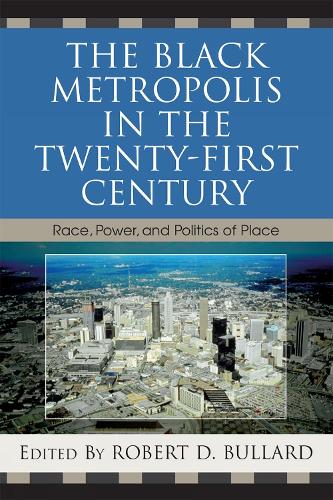
The Black Metropolis in the Twenty-First Century: Race, Power, and Politics of Place
(Paperback)
Publishing Details
The Black Metropolis in the Twenty-First Century: Race, Power, and Politics of Place
By (Author) Robert D. Bullard
Contributions by Angela Glover Blackwell
Contributions by Edward J. Blakely
Contributions by David A. Bositis
Contributions by Sheryll Cashin
Contributions by Joe T. Darden
Contributions by J Eugene Grigsby III
Contributions by Glenn S. Johnson
Contributions by john a. powell
Contributions by Michael A. Stoll
Bloomsbury Publishing PLC
Rowman & Littlefield Publishers
3rd May 2007
United States
Classifications
General
Non Fiction
Urban and municipal planning and policy
Ethnic studies / Ethnicity
Public administration / Public policy
307.764089073
Physical Properties
Paperback
294
Width 155mm, Height 228mm, Spine 20mm
472g
Description
This book brings together key essays that seek to make visible and expand our understanding of the role of government (policies, programs, and investments) in shaping cities and metropolitan regions; the costs and consequences of uneven urban and regional growth patterns; suburban sprawl and public health, transportation, and economic development; and the enduring connection of place, space, and race in the era of increased globalization. Whether intended or unintended, many government policies (housing, transportation, land use, environmental, economic development, education, etc.) have aided and in some cases subsidized suburban sprawl, job flight, and spatial mismatch; concentrated urban poverty; and heightened racial and economic disparities.
Written mostly by African American scholars, the book captures the dynamism of these meetings, describing the challenges facing cities, suburbs, and metropolitan regions as they seek to address continuing and emerging patterns of racial polarization in the twenty-first century. The book clearly shows that the United States entered the new millennium as one of the wealthiest and the most powerful nations on earth. Yet amid this prosperity, our nation is faced with some of the same challenges that confronted it at the beginning of the twentieth century, including rising inequality in income, wealth, and opportunity; economic restructuring; immigration pressures and ethnic tension; and a widening gap between "haves" and "have-nots." Clearly, race matters. Place also matters. Where we live impacts the quality of our lives and chances for the "good life."
Reviews
Bullard has done a service with this collection for those looking for information and prospects for urban and suburban African Americans in the contemporary U.S. Recommended. * Choice Reviews *
Robert Bullard has assembled a rich and highly readable collection of scholarly work on the role of race in assigning where and determining how Americans live. The contributors provide trenchant analyses not only of the way limited housing access is created through loan barriers, but of the consequential vulnerability of those thereby exposed to environmental pollution. Equally importantly, the authors present useful ideas on what can and should be done to correct these very serious problems.... -- Troy Duster, Emeritus Chancellor's Professor, University of California, Berkeley
Robert Bullard has assembled a rich and highly readable collection of scholarly work on the role of race in assigning where and determining how Americans live. The contributors provide trenchant analyses not only of the way limited housing access is created through loan barriers, but of the consequential vulnerability of those thereby exposed to environmental pollution.
Equally importantly, the authors present useful ideas on what can and should be done to correct these very serious problems.
Author Bio
Robert D. Bullard is the Ware Distinguished Professor of Sociology and Director of the Environmental Justice Resource Center at Clark Atlanta University. He is the author of thirteen books that address sustainable development, environmental racism, urban land use, industrial facility siting, community reinvestment, housing, transportation, and smart growth. His most recent book is entitled Growing Smarter: Achieving Livable Communities, Environmental Justice and Regional Equity (MIT Press 2007).
